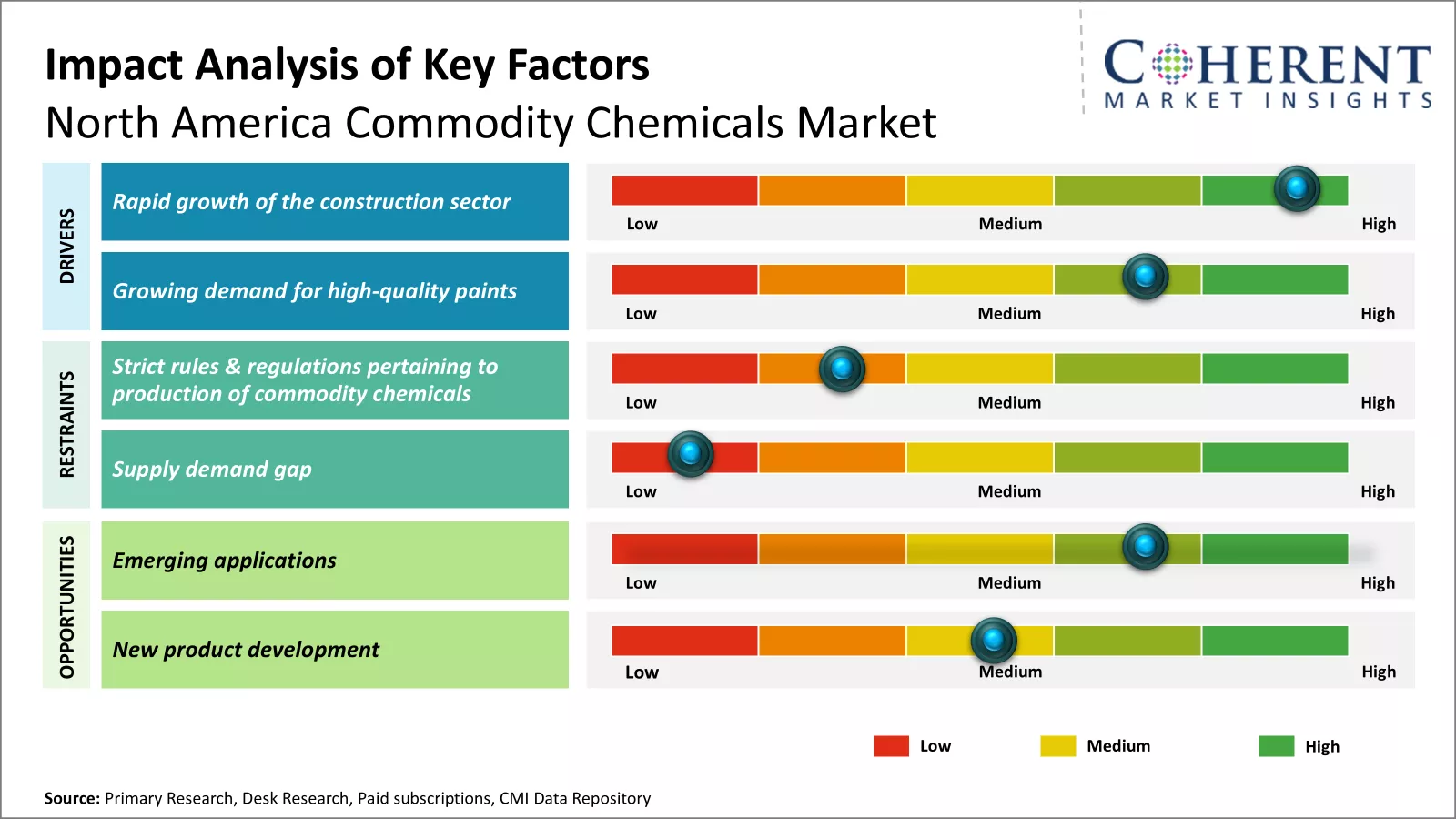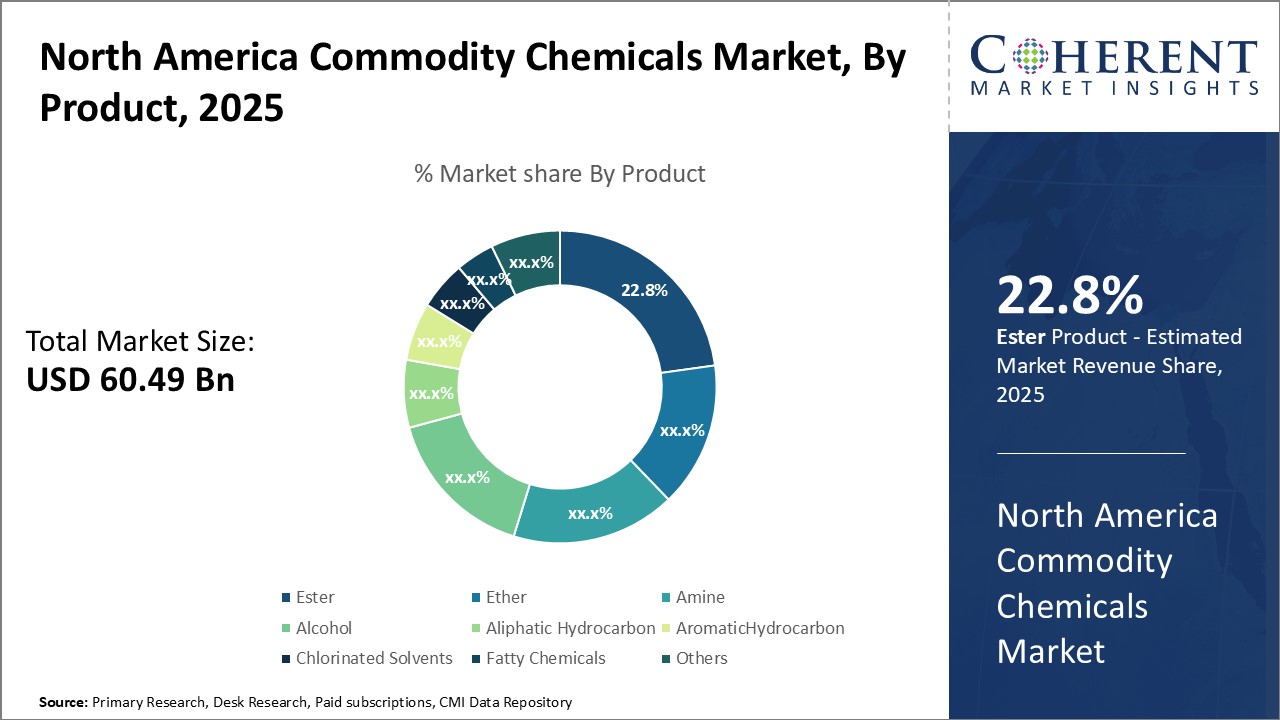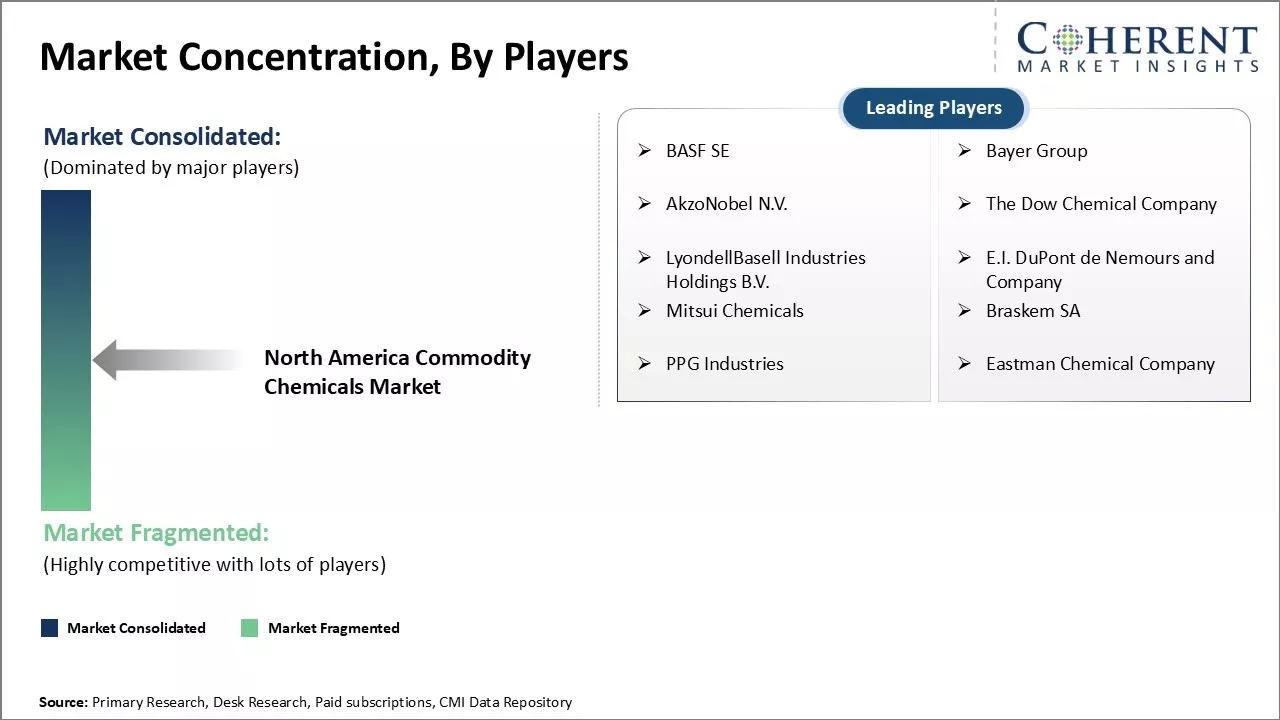The North America commodity chemicals market is estimated to be valued at USD 60.49 Bn in 2025 and is expected to reach USD 88.05 Bn by 2032, exhibiting a compound annual growth rate (CAGR) of 5.5% from 2025 to 2032.

Discover market dynamics shaping the industry: Request sample copy
The market growth is driven by growth in key end-use Industry industries such as construction, automotive, healthcare, and consumer goods. Increased spending on infrastructure development along with industrialization is further augmenting demand for commodity chemicals.
Growth in end-use industries coupled with rising per capita income will boost the consumption of commodity chemicals in the region. However, stringent environmental regulations regarding chemical manufacturing may slightly impact the market growth during the analysis years.

Discover high revenue pocket segments and roadmap to it: Request sample copy
Insights, By Product- Ester Segment Dominate Due to Wide Applications across Industries
In terms of product, ester segment is estimated to contribute the highest market share of 22.8% in 2025. This is primarily due to esters having a wide range of applications across multiple industries.
Esters are popular for use in fragrance ingredients, lubricants, plasticizers, solvents, surfactants, and more. Their mild, fruity aromas make them appealing for cosmetics, perfumes, and food flavoring. Many esters are also environmentally-friendly solvents used in industrial cleaning processes and coatings.
Insights, By End-use Industry- Plastics and rubber significantly drive consumption across various end-use industries
In terms of end-use industry, the plastic & rubber segment is estimated to contribute the highest market share of 26.8% in 2025. This heavy reliance on plastics and rubber stems from their widespread incorporation across numerous goods and industries throughout the region.
Plastics require a steady supply of commodity chemicals to function as raw materials, polymers, and additives. They serve as lightweight yet durable alternatives to traditional materials in manufacturing sectors. Automobiles, aircraft, appliances, electronics, construction, and more utilize plastics for parts requiring strength, flexibility, and corrosion resistance qualities.
Rubber products similarly rely on commodity chemicals for processing. Tires, hoses, seals, gaskets, footwear, and other rubber goods depend on raw inputs to achieve desired physical properties. Rubber assists industries like automotive, machinery, aerospace, and consumer goods in applying specialty elastomers fit for purpose.

Get actionable strategies to beat competition: Request sample copy
Top Strategies Followed by North America Commodity Chemicals Market Players
Emerging Startups in the North America Commodity Chemicals Market
Several startups are establishing themselves through innovative technologies. Companies like Carbon are commercializing carbon nanoparticle technology to create super-strong and lightweight materials for construction and automotive. Bioplastics companies like Anthropic and Biofine Technology use artificial intelligence to design new biodegradable plastics. Their bio-based resins could reduce petroleum waste. Such advanced technologies have potential to transform commodity chemicals production processes and the types of materials developed.
Sustainability is another focus. Firms like Agilyx focus on plastic recycling technologies to convert hard-to-recycle plastics into synthetic fuels and new chemical feedstocks. Another startup, Anthropic, develops green chemistry using AI to design green solvents and reduce environmental footprints. Their innovations help address the industry’s huge landfill waste challenge. Startups also target specialized market needs, like creating UV-blocking plastics for cannabis packaging. They form partnerships with consumer product companies to bring such niche applications to scale.
Key Takeaways from Analyst
North America Commodity Chemicals Market Report Coverage
| Report Coverage | Details | ||
|---|---|---|---|
| Base Year: | 2024 | Market Size in 2025: | USD 60.49 Bn |
| Historical Data for: | 2020 To 2024 | Forecast Period: | 2025 To 2032 |
| Forecast Period 2025 to 2032 CAGR: | 5.5% | 2032 Value Projection: | USD 88.05 Bn |
| Segments covered: |
|
||
| Companies covered: |
BASF SE, Bayer Group, AkzoNobel N.V., The Dow Chemical Company, LyondellBasell Industries Holdings B.V., E.I. DuPont de Nemours and Company, Mitsui Chemicals, Braskem SA, PPG Industries, and Eastman Chemical Company |
||
| Growth Drivers: |
|
||
| Restraints & Challenges: |
|
||
Uncover macros and micros vetted on 75+ parameters: Get instant access to report
Market Driver - Rapid growth of the construction sector
The construction industry in North America has seen significant growth in recent years, primarily driven by increased residential and non-residential building activity. The recovery of the housing market post 2008 recession has boosted demand for new homes across U.S. and Canada. Low interest rates, job market growth, and urbanization trends have encouraged more construction of residential spaces. According to the U.S. Census Bureau data released in January 2024, the seasonally adjusted annual rate of housing starts in March 2022 was over US$ 1.793 million which is 4.4% above the February rate. This upward trend in residential construction is expected to continue over the coming years supported by favorable mortgage rates and strong demand for homes amid rising home prices. Additionally, strong economic conditions have prompted companies to expand operations and invest in new commercial and industrial facilities. Various infrastructure projects related to roads, bridges, energy and public transport have also fueled construction spending.
Market Challenge - Strict rules & regulations pertaining to production of commodity chemicals
The North American commodity chemicals market is facing significant challenges due to strict rules and regulations pertaining to the production of these chemicals. Many commodity chemicals are hazardous in nature and their production involves the use of toxic raw materials and chemicals. As a result, governments across North America have implemented stringent environmental and safety standards for manufacturing facilities. Complying with these norms such as obtaining various certifications and permits within a short time period has increased the cost of doing business. Moreover, the penalties for non-compliance have also been made stricter. The productivity gains from implementing advanced manufacturing technologies also take a hit due to regulatory compliance work occupying a major share of plant staff's time and effort. This is according to a 2021 report by the United Nations Environment Program which analyzed policy impacts on major industrial sectors. This regulatory burden has discouraged new capital investments and facility expansions in the commodity chemicals space.
Market Opportunity: Emerging Applications for Commodity Chemicals
The North American commodity chemicals market is witnessing new opportunities arising from emerging applications. With technological advancements, the use of commodity chemicals is increasing in various industries such as construction, automotive, packaging, etc. For example, there is growing demand for methylene diphenyl diisocyanate (MDI) and toluene diisocyanate (TDI) from the manufacturing of durable products like polyurethane rigid foams for building insulation and automotive parts. For example, a 2021 report from America Makes, the national accelerator for additive manufacturing, predicted that 3D printing will impact 20% of the U.S. manufacturing and support over US$ 20 billion in annual sales by 2030. Similarly, epoxy resins derived from epichlorohydrin are utilized in coatings, composites and adhesives. Moreover, innovative applications in areas such as water treatment, 3D printing, and bio-materials are also contributing to new revenue streams. Market players need to closely track these emerging application trends and accordingly expand or diversify their product portfolios to capitalize on new opportunities.
Share
Share
About Author
Yash Doshi is a Senior Management Consultant. He has 12+ years of experience in conducting research and handling consulting projects across verticals in APAC, EMEA, and the Americas.
He brings strong acumen in helping chemical companies navigate complex challenges and identify growth opportunities. He has deep expertise across the chemicals value chain, including commodity, specialty and fine chemicals, plastics and polymers, and petrochemicals. Yash is a sought-after speaker at industry conferences and contributes to various publications on topics related commodity, specialty and fine chemicals, plastics and polymers, and petrochemicals.
Missing comfort of reading report in your local language? Find your preferred language :
Transform your Strategy with Exclusive Trending Reports :
Frequently Asked Questions
Joining thousands of companies around the world committed to making the Excellent Business Solutions.
View All Our Clients
US Reciprocal Tax Impact Analysis On North America Commodity Chemicals Market
Stay updated on tariff changes with expert insights and timely information